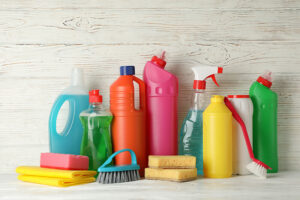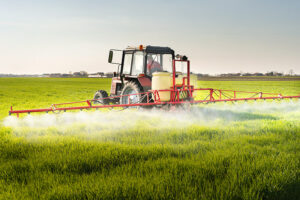Did You Know That Your Home Could Be Toxic?
Our homes should be a haven and place of tranquility and rest, right? But did you know that your home could be toxic?
Toxins cause inflammation in our bodies. While we cannot eliminate all toxins we can definitely limit what we are exposed to and change what we can.
The following is a great reference we found that was put together by Angela Sisk an Oncology Nurse Navigator at Memorial Hermann Cancer Center – Greater Heights. Sisk has booted toxic products from her home and replaced them with all-natural versions.
Here are a few chemicals found in cleaning products to stay clear of:
- Benzene: is a chemical used in some laundry and dishwashing detergents.
- Chlorine: is a chemical used in some laundry products, toilet bowl cleaners, and all purpose cleaners.
- Phenol: is a chemical that is found in disinfectant products and some paints.
- Formaldehyde: is found in bathroom disinfectants, carpet and rug cleaners, and also furniture polish.
- Some fabric softeners: while they may smell great, have countless neurotoxins, which means toxicity to the brain and nervous system. Air fresheners such as sprays, plug-ins and candles may contain formaldehyde benzene and other chemicals.
Be careful to check ingredients when buying cleaning products. The less ingredients the better. These harmful chemicals can build up in our system over time and cause current and future health issues.
Remember some toxins in our environment we can’t control, but the things we can it is important to take healthy steps to prevent exposure.
Here are six top toxic offenders – and their alternatives
Toxic Offender: Liquid fabric softeners and dryer sheets
 Culprit: Those may contain benzyl acetate, ethanol and chloroform, possibly linked to Alzheimer’s, central nervous disorders and Multiple Sclerosis, Sisk says. “It’s surprising how many chemicals are in these products.”
Culprit: Those may contain benzyl acetate, ethanol and chloroform, possibly linked to Alzheimer’s, central nervous disorders and Multiple Sclerosis, Sisk says. “It’s surprising how many chemicals are in these products.”
Snitch: The U.S. Environmental Protection Agency guides consumers by partnering with manufacturers who use less harmful chemicals.
Healthy Choice: Wool dryer balls, scented with a few drops of essential oils, also help reduce static electricity.
Good to Know: You can order reusable dryer balls via Amazon. Or look for the EPA’s Safer Choice logo and list of partner products.
Toxic Offender: Candles, commercial air fresheners and other aerosols
 Culprit: Candle wicks may contain lead, which may be linked to behavioral disorders. When burned, paraffin wax releases known human carcinogen benzene and “reasonably anticipated to be human carcinogen” toluene. Commercial air fresheners may contain volatile organic compounds (VOCs) which interfere with reproduction and cellular regeneration, as well as phthalates, believed to impede male hormone production.
Culprit: Candle wicks may contain lead, which may be linked to behavioral disorders. When burned, paraffin wax releases known human carcinogen benzene and “reasonably anticipated to be human carcinogen” toluene. Commercial air fresheners may contain volatile organic compounds (VOCs) which interfere with reproduction and cellular regeneration, as well as phthalates, believed to impede male hormone production.
Snitch: The National Toxicology Program’s list of carcinogens is updated regularly, most recently in 2016. The U.S. Consumer Product Safety Commission (CPSC) found half of scented candles suspect.
Healthy Choice: Use a diffuser filled with water and a few drops of all-natural essential oils.
Good to Know: Benzene can be found in cigarettes and toluene in many nail polishes.
Toxic Offender: Frozen dinner trays, plastic storage containers and plastic food wrap
 Culprit: Bisphenol-A (BPA), also found in the lining of cans, has been linked to fertility, behavioral issues and faster physical development in girls. “They’re not linked directly to breast and prostate cancer but are possibly linked due to BPAs being endocrine disrupters,” Sisk says.
Culprit: Bisphenol-A (BPA), also found in the lining of cans, has been linked to fertility, behavioral issues and faster physical development in girls. “They’re not linked directly to breast and prostate cancer but are possibly linked due to BPAs being endocrine disrupters,” Sisk says.
Snitch: The NTP lists known and suspected carcinogens.
Healthy Choice: Store foods in glass containers and do not microwave or freeze in plastic.
Good to Know: “Plastic lids are OK if they don’t touch food,” Sisk says.
Toxic Offender: Furniture polish and bathroom and household cleansers
 Culprit: Household products are not closely regulated. They may contain formaldehyde, nitrobenzene, methylene chloride – suspected human carcinogens – and reproductive hormone disruptors and asthma inducers. Aerosols, detergents and furniture polish also may contain VOCs such as terpenes. The last reacts with ozone indoors to form formaldehyde, a known human carcinogen, reports the Environmental Working Group.
Culprit: Household products are not closely regulated. They may contain formaldehyde, nitrobenzene, methylene chloride – suspected human carcinogens – and reproductive hormone disruptors and asthma inducers. Aerosols, detergents and furniture polish also may contain VOCs such as terpenes. The last reacts with ozone indoors to form formaldehyde, a known human carcinogen, reports the Environmental Working Group.
Snitch: The National Toxicology Program brands benzene and formaldehyde as “known human carcinogens.” So does the International Agency for Research on Cancer. EWG’s Guide to Healthy Cleaning aids consumers.
Healthy Choice: Add a capful of Young Living Thieves cleaner to a glass spray bottle filled with water. “I use it on everything,” she says. Or buy products identified as EPA Safer Choices and/or certified with “Green Seal” or “Ecologo.”
Good to Know: Avoid triclosan, ethanolamines, chlorine bleach (sodium hypochlorite) and quarternary ammonium compounds, the last of which are suspected of being linked to birth defects in animals, according to EWG. “Even products advertised as ‘green’ or ‘natural’ may not be, There’s a term for making untrue claims: ‘green washing.’ Do your own research and read labels.
Toxic Offender: Pesticides and mosquito repellents
 Culprit: These bug killers also are found on the surface of fresh produce.
Culprit: These bug killers also are found on the surface of fresh produce.
Snitch: Heed the U.S. Environmental Protection Agency. EWG cites strawberries, apples, celery and spinach among veggies and fruits most likely to have pesticide residue.
Healthy Choice: In addition to better known Citronella, Sisk recommends crushed lavender petals, Neem Oil and Diatomaceous Earth. She prefers organic fruits and vegetables, and recommends soaking all produce in water with a tablespoon of baking soda for two minutes or longer before consuming.
Good to Know: The EPA screens chemical repellents for carcinogenic risk.
Toxic Offender: PVC/vinyl
 Culprit: This material is banned in the European Union and Japan. Still, PVC is found in shower curtains, garden hoses, toys and credit cards. It expels phthalates, again possibly linked to infertility and cancer.
Culprit: This material is banned in the European Union and Japan. Still, PVC is found in shower curtains, garden hoses, toys and credit cards. It expels phthalates, again possibly linked to infertility and cancer.
Snitch: American Cancer Society recommends checking out the International Agency for Research on Cancer.
Healthy Choice: Look for non-toxic PVC versions. Shower curtains can be made of hemp, linen, birch and organic cotton.
Good to Know: Pacifier and rattle makers agreed to heed the CPSC’s request to remove two phthalates in 1998.
Keep in mind that just because a substance has been designated – or suspected – as a carcinogen does not mean it will cause cancer. Many factors influence whether a person exposed to a carcinogen will develop cancer, including the amount and duration of exposure and the individual’s genetic background.
Also do not forget these following lifestyle choices that can contribute to risk of cancer, the nation’s second highest killer: obesity, smoking, inactivity and poor diet. Make your health your priority!
